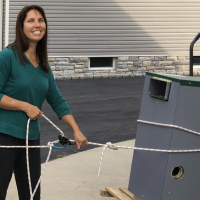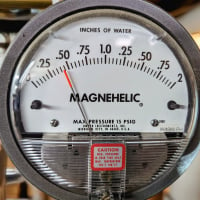Main vents on Steam system
What’s the best place to install some main vents on a one pipe system. It seems I will have to place one before my last radiator riser. Is that ok?
Comments
-
Yes. The amount of pipe between the main vent and the last radiator takeoff, is probably minimal. Of course, pictures would help. You could always slightly oversize that radiator air vent, if necessary
0 -
-
they can also go in a drop to a wet return at the end of the main if you have access to that but not the end of the main itself
0 -
Question to ED on VENTING :
By ED above: "... If the steam and condensate come back to the boiler above the water line they can go near the boiler before the drop"
To ED: I have older DOLE vents ( i think#5) at the ends of two dry returns (one connected to front steam main and the other the back of house steam main) I have single pipe steam where the two dry returns drop down into wet returns both about 5 feet from boiler on either side. I added a few vents at the end of the steam mains ( each about 50 feet in length) on a tree a number of years ago that I believe brought the steam to the last radiators faster - but was not aware of your recommendation above. Is it acceptable to have venting at end of steam mains, as well as near boiler as described?
I may have misread comment, but wanted to be sure
Regards,
RTW
0 -
In your situation, @RTW , it really doesn't make much difference whether the vents on the steam mains are at the far ends beyond the last radiator or back at the boiler before they drop individually to a wet return/boiler inlet. In fact, from the perspective of the air and the steam arriving at a radiator it makes no difference at all. The only practical difference is that with the vents at the boiler, that whole section of line from the last radiator to the boiler gets steam, whereas when the vents are at the far end, it wouldn't.
And note. VERY CAREFULLY. The above applies when that "dry return" is directly connected to the steam main — no traps or whatnot. If the dry return is a true dry return, which is only found in two pipe systems, the comment above does NOT apply.
Br. Jamie, osb
Building superintendent/caretaker, 7200 sq. ft. historic house museum with dependencies in New England2 -
Hello Jamie
So, to follow -up in my single pipe system, do I remove the DOLE vents near boiler to gain more steam to radiators that the vents at the end of the mains serve on a tree? It seems steam in the dry return is wasted. BTW, I believe the steam mains are longer than 50 feet maybe 70 without measurement. Thus, the dry returns are about the same length
I suppose I could experiment and cap the DOLES temporarily to see if it makes a difference
Regards,
RTW
0 -
@RTW , if the mains really are that long, you need some serious venting. I'd start with a Gorton #2 on each. Please confirm the lengths, also the pipe sizes.
All Steamed Up, Inc.
Towson, MD, USA
Steam, Vapor & Hot-Water Heating Specialists
Oil & Gas Burner Service
Consulting0 -
No need to remove the Doles — they're really not doing much of anything anyway. Too small. As @Steamhead said, if your mains are that big, you need much more serious venting — but it can go anywhere after the last radiator takeoffs.
Br. Jamie, osb
Building superintendent/caretaker, 7200 sq. ft. historic house museum with dependencies in New England0 -
and if you do put them at the boiler at the end of the "dry returns" you only need to consider the length of the main to the last radiator runnout, once the steam gets there, it doesn't matter how long it takes to get through the return to the vent.
0 -
Well….except that steam will get used to heat that "dead" part of the main, and steam will have to fill it. Therefore I think you should count it. Or even better, put your main venting before that dead part of the main.
NJ Steam Homeowner.
Free NJ and remote steam advice: https://heatinghelp.com/find-a-contractor/detail/new-jersey-steam-help/
See my sight glass boiler videos: https://bit.ly/3sZW1el1 -
-
it will get heated but it won't delay your emitters heating so you really just need to balance venting to the last emitters.
0 -
It will absolutely delay the emitters getting steam (steam can't heat both at the same time and rate as one) but that's all I'll say about it hopefully
NJ Steam Homeowner.
Free NJ and remote steam advice: https://heatinghelp.com/find-a-contractor/detail/new-jersey-steam-help/
See my sight glass boiler videos: https://bit.ly/3sZW1el1 -
it cant' heat both, but once it gets to the runout for the emitter it will start heating both. if the vent for the main is faster more will go to heating the main than to heating the runout.
0 -
-
I am always lying when I say I'm done replying, sorry world!
The steam does possibly travel up EVERY runout on its way to the main vents, but since the main vent should be the least resistive pressure-wise, that's where the majority would go. And in fact (I haven't tested this) it may even be that the steam doesn't go up any runouts at all until the main vents are shut (if they are close to correctly-sized), due to bernoulli or whoever. (the same reason that branches on heating ducts don't get any flow unless the main branch is reduced just after each runout)NJ Steam Homeowner.
Free NJ and remote steam advice: https://heatinghelp.com/find-a-contractor/detail/new-jersey-steam-help/
See my sight glass boiler videos: https://bit.ly/3sZW1el0 -
they haven't done graduated ductwork since like the 50's
0 -
I am very ignorant of this topic, but in every modern open-ceiling place I look at, I see it (shrug)
NJ Steam Homeowner.
Free NJ and remote steam advice: https://heatinghelp.com/find-a-contractor/detail/new-jersey-steam-help/
See my sight glass boiler videos: https://bit.ly/3sZW1el0 -
Just a simple theoretical example. Say you had 10 radiators on a system venting at say 0.175cfm each and a main vent at the end of the return back at the boiler venting at 1.75cfm. When the steam passes the first takeoff the % steam going to the radiator vs continuing on downstream should be roughly proportional to the venting rates of the two path choices. With this example that would work out to .175cfm toward the radiator and (9*.175)+1.75 or 3.325cfm of venting downstream. So 95% of the steam should continue downstream whereas 5% would head toward the radiator. When the second radiator takeoff is passed by the steam there would be .35cfm of venting for the combined two radiators and 3.15cfm venting downstream. So 90% of the steam would continue downstream and 5% would go to radiator 1 and another 5% to radiator 2. When the steam passes the last takeoff each of the 10 radiators would be receiving 5% of the steam but 50% of the steam would still travel toward the main vent until closed. After the main closed 10% of the steam would be going to each radiator.
To me placement really just depends upon whether you want the heat in the basement or not and whether placement immediately after the last takeoff is feasible or not. If the answers are no and yes then put them at the ends of the mains.
0 -
In large systems they reduce the trunk as the load gets smaller, but that is just for cost savings. Most residential systems just use one size trunk. They aren't like my system that was installed around 1950 where the trunk reduces at each takeoff and every piece was custom fabricated for the system including the rectangular ducts to the registers themselves.
0 -
IMO, the take off piping and rads are full of air.
Some steam would start flowing into the take offs but has to push air ahead of it.
And that air has to vent thru the entire rad and then thru small air vents.
So I think the main would/should fill first and then the rads slowly.
Then the return would fill up to the air vents, assuming they are in the boiler room, the steam would already be at the last rad take off by the time those main air vents close.
The heat delivered by the long "dry" return is within the insulated envelope of the structure and not lost. If basement is too warm you should insulate the piping.
0 -
Everyone's advice is greatly appreciated and maybe I was over thinking it. I have three ports on a tree for longest run and currently use just two vented with Gorton # 1& #2. The shorter run has two ports on a tree, but use only one Gorton #1. I added three (3) more radiators to existing system so boiler is likely maxed out. I previously balanced venting system - trial & error - over the years, cold siphoned boiler many times after adding new radiators and had a professional who used a product called "dry steam" to clean system after adding radiators ( all this done years ago) I have the boiler serviced once a year and change out the oil filter 2x per year. I have boiled the vents periodically to clean now and then ( 3 to 5 minutes in white vinegar). My well water does have some iron but after adding a sediment filter it was cut down to next to nothing
I doubt the average homeowner would put in the effort and research into maximizing a steam system today. I believe the original install of the one pipe steam system back in the late 50s or early 60s knew what they were doing and had what I call ports along the Mains to add more radiators if desired. I hardly need to add water to system, and it operates quiet as a mouse due to my efforts; and from a lot of advice gleaned from Heatinghelp.com.
Regards,
RTW
0 -
It's likely those "ports" were from someone along the way removing radiators.
NJ Steam Homeowner.
Free NJ and remote steam advice: https://heatinghelp.com/find-a-contractor/detail/new-jersey-steam-help/
See my sight glass boiler videos: https://bit.ly/3sZW1el1 -
Every duct system I've seen, well, almost everyone has the size reduced as you go. Except the system I installed, that's one size the entire way, 14" round in two directions. I've never noticed an issue with distribution in my own system at all. However, this is an area I'm not really good at, and there's plenty out there that understand it far, far, far more than I do.
As far as runouts not getting steam until it hits the end, and steam only taking the path of least resistance I've never found that to be true, just as it's not true with electricity. All paths are taken. In fact, I used this to my advantage when doing my balancing. You can make it less likely to go up the runouts before the main, but you won't stop it completely.
Single pipe 392sqft system with an EG-40 rated for 325sqft and it's silent and balanced at all times.
0
Categories
- All Categories
- 87.3K THE MAIN WALL
- 3.2K A-C, Heat Pumps & Refrigeration
- 61 Biomass
- 429 Carbon Monoxide Awareness
- 120 Chimneys & Flues
- 2.1K Domestic Hot Water
- 5.8K Gas Heating
- 114 Geothermal
- 166 Indoor-Air Quality
- 3.7K Oil Heating
- 77 Pipe Deterioration
- 1K Plumbing
- 6.5K Radiant Heating
- 395 Solar
- 15.7K Strictly Steam
- 3.4K Thermostats and Controls
- 56 Water Quality
- 51 Industry Classes
- 50 Job Opportunities
- 18 Recall Announcements






